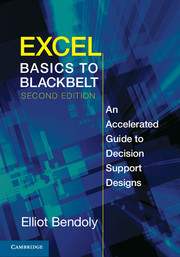Book contents
- Frontmatter
- Contents
- Associated Links
- Preface
- Section 1 Getting Oriented
- Section 2 Harvesting Intelligence
- Section 3 Leveraging Dynamic Analysis
- Section 4 Advanced Automation and Interfacing
- 11 Visual Basic Editing and Code Development
- 12 Automating Application Calls
- 13 Guided and User-Friendly Interfaces
- Glossary of Key Terms
- Appendix: Shortcut (Hot Key) Reference
- Index
12 - Automating Application Calls
Published online by Cambridge University Press: 05 August 2013
- Frontmatter
- Contents
- Associated Links
- Preface
- Section 1 Getting Oriented
- Section 2 Harvesting Intelligence
- Section 3 Leveraging Dynamic Analysis
- Section 4 Advanced Automation and Interfacing
- 11 Visual Basic Editing and Code Development
- 12 Automating Application Calls
- 13 Guided and User-Friendly Interfaces
- Glossary of Key Terms
- Appendix: Shortcut (Hot Key) Reference
- Index
Summary
Many applications such as Microsoft MapPoint and RISKOptimizer can be leveraged through the primary interfaces with which they were designed, but they can also be called from behind the scenes through the same Visual Basic (VB) developer environment discussed in Chapter 11. From a decision support development perspective, there are several advantages to making such calls from behind the scenes. First and foremost, behind the scenes control can eliminate the need for users to become acquainted with alternative interfaces in the course of using a DSS that leverages their capabilities. Another advantage is the potential avoidance of outputs that automatically accompany the use of these applications, but are nevertheless visual and information distractions from the main point of the DSS design. The appearance of seamlessness in a designed DSS is also facilitated by VB-driven automated calls to applications. This has the potential for engendering greater confidence in the developed DSS, as well as in the developers. This chapter covers several approaches to working with such applications in roughly the order in which they have been introduced throughout this book.
Calls to MapPoint
The Chp12_MapPointCall workbook provides a template through which we can demonstrate how Excel, through VB, can leverage some of the functionality of MapPoint. As with all other demonstrations in this chapter, we'll present only a smattering of what can actually be done. To start, let's consider a hypothetical need to get information regarding a route that starts in Seattle and passes through four additional cities before returning to Seattle. The workbook outlines these stops (shown in Figure 12.1).
- Type
- Chapter
- Information
- Excel Basics to BlackbeltAn Accelerated Guide to Decision Support Designs, pp. 334 - 358Publisher: Cambridge University PressPrint publication year: 2013



